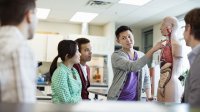Integrating Social and Emotional Competencies Into Academic Content
Collaboration, problem solving, and social awareness are as necessary as literacy and math.
Your content has been saved!
Go to My Saved Content.The term college and career ready is used often, and there are many of us who believe that social and emotional competencies are part of that readiness. But what does that mean in practice?
Dr. Tara Laughlin, a former teacher and passionate advocate for developing students’ social-emotional skills that she believes are necessary for college and career readiness, explained to me recently that these skills don’t just materialize—they must be taught. But because of high-stakes accountability, many teachers are hesitant to spend instructional time focusing on anything not directly related to content.
“The world is changing, and graduating from high school with foundational knowledge in reading, writing, math, science, and social studies is no longer enough to be college and career ready," explained Laughlin. "Success is also linked to competencies such as collaboration, problem solving, and social awareness, often referred to as 21st-century or social-emotional skills.”
Integrating Standards and Emotions
Since my conversation with Laughlin, the Aspen Institute has come out with an important new report, This Time, with Feeling: Integrating Social and Emotional Development and College- and Career-Readiness Standards. The executive summary of the report’s findings states, in part:
"Instruction that promotes students’ social and emotional development (SED) facilitates better student outcomes on college- and career-ready (CCR) standards. The converse is also true: Learning environments structured to genuinely meet rigorous standards support the development of students’ social and emotional skills. To promote deeper learning, educators need to make the most of this interconnected relationship, and to approach SED not as an add-on or discrete intervention, but as an integral part of the academic program."
We know that being in college and starting a career are both highly emotion-laden experiences. It makes great sense to integrate social and emotional aspects of learning with content learning, allowing students to see from the outset how to sort out what they know, what they need to know, their feelings, and how to interact with others to accomplish their goals. This also shows them that this kind of integration is an ongoing process, in learning and in life.
The idea that we can simply teach academic content and social-emotional competencies in silos is unsupportable by theory, research, and biology. The Aspen report provides examples from grades K through 12 of how, as they put it, SED and CCR are reciprocal in benefit to students and set up a virtuous cycle of greater accomplishment than one would get from either approach in isolation.
So what does this mean for educators? How can they address these essential social-emotional skills in with their students while also teaching the required content?
Integrating SEL into Preexisting Units
One example is a framework developed by Laughlin that allows educators to design units of instruction that integrate social and emotional learning (SEL) into the college and career readiness content they are teaching.
Here’s how this approach might look from the perspective of a team of three eighth-grade science teachers who begin planning together their next unit of instruction on the scientific method. The science teachers consider which skills they will incorporate into their unit. They ask themselves questions such as:
- Which skills will lend themselves most naturally to integration with our content, the scientific method?
- Which SEL-related skills have we noticed our students are lacking?
Based on these considerations, according to Laughlin, the teachers decide they will integrate two SEL skills into this unit—problem solving and self-control.
Next, the teachers pre-assess their students on the scientific method, problem solving, and self-control. They use their existing scientific method pre-assessment from the previous year, and to assess the skills they design a simple performance task for students to complete. They then use backward design to plan their unit. They break the three areas (the scientific method, problem solving, and self-control) down into a series of smaller concepts that need to be taught.
After initial instruction, the teachers design practice activities for their students that allow them to connect concepts in both content and skills in tandem. They observe these practice activities to gain insights and to provide students with additional time and support.
With this approach, educators are able to use units they’ve already designed or units required by their school or district (for other essential college and career content) and integrate social-emotional competencies into their direct instruction.
